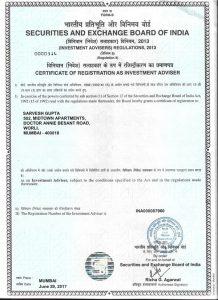2017 is coming to an end. When I look at data for performance for some of the momemtum chasing media friendly fund managers (these guys are quite active on Twitter as well), I can’t help but comment because I somehow find too many gullible investors fall for statistics at exactly the wrong time. So, for the benefit of all, I want to lay down few points.
- Compounded Annual Returns is something not intutive to human mind.
For instance if I ask you what will be your net retuns per year in 5 years if your performance is like this : +40%, +40%, +40%, +40%, -50%. Most likely it wouldn’t seem to us that performance CAGR drops to a mere 14%. However someone who does +20%, +20%, +20%, +20%, 0% achieves 16% – a seemingly small but important 2% point difference. And much better even after achieving just half of the returns shown by the first guy in 4 out of 5 years as he manages to save the investors by not becoming all go-go investor in the bull market. Still if this 2% difference per year doesnt excite you, assuming you are a PMS investor at the age of 40 and you are working somewhere else and want a comfortable retirement – this difference of 2% per year will create a differnce of 50% difference in wealth when you retire at the age of 60 – this will give you a different standard of living all together as 50% difference will all fall in your discretionary expenditure – very important for the standard of life in retirement.
So bottomline of first point is – Compounding of wealth is magical but making money isn’t as important as retaining it is. It is very important to not have massively down years and the thoughtful portfolio manager’s portfolio is tilted towards this consideration. So avoid risk but more so when markets are appearing expensive.
- There are three kinds of lies – Lies, Damned Lies and Statistics
Now this is interesting. Why would a manager who famously invests mostly in micro-caps and at best small caps compare his performance to NIFTY and BSE500 rather than a index like BSE Small Cap (which by the way is also not representative for many of the micro and small caps bets). Less than 15% of BSE 500 companies have market cap less than 3000 cr and again is not representative to bets. A 79% looks massive compared to 28% of NIFTY but not so great when BSE Small cap index which is an index of more than 700 companies is itself up by 60% in CY17. The answer is simple : because the Alpha of returns comparing it to BSE500 or NIFTY looks much more great. I bet many such managers start comparing themselves to BSE Small cap index in a bad years – as BSE Small cap will get massacred in a down market and it will again make the underperformance look better relatively speaking.
- The concept of Risk Adjusted Returns
Unfortunately, most of us are inclined to look at returns only as they are far more objective but not look at risk adjusted returns. Classic Corporate Finance theory tells us that returns can always be expected to go higher if risks are. While I believe that there are a set of distinctive portfolio managers who will beat this equation and show that market anomalies exist so that returns can be increased without taking excessive risk but then not everybody belongs to this elite set (and I bet any manager who is regular on twitter and CNBC don’t belong to this elite group either). Now this was a year when taking massive risk led to massive performance. Forget BSE Small Cap Index which is up 60% or this Portfolio which is up 79%, BSE Realty which maybe consists of most volatile and low quality company is almost up 100%. Taking higher risk is like driving fast – you may reach early sometimes (like managers who took higher risk this year) but sometimes you will just crash. Unfortuanately we feel pity for the guy who died and we hail the guy who came first – while we should pity both. Shouldn’t we?
This is what two of the world’s best investors – Buffett & Seth Klarman say about performance to their investors:
“I have pointed out that any superior record which we might accomplish should not be expected to be evident by a relatively constant advantage in performance compared to average. Rather it is likely that if such an advantage is achieved, it will be through better-than-average performance in stable or declining markets and average, or perhaps even poorer-than-average performance in rising markets” Warren Buffett, Partnership letter 1960
“The true investment challenge is to perform well in difficult times. It is unfortunately not possible to reliably predict when those times might be. The cost of performing well in bad times can be relative underperformace in good times. We have always judged that a worthwhile price to pay” Seth Klarman
Bottomline is the go-go managers who outperform the index in a year like this should be evaluated cautiously. Best of the managers will probably underperform as the bullish market stays strong as they get more and more risk averse before the market actually tops out. Hence they are psychologically prepared to take full advantage of bearish markets since they dont loose much and actually have cash to invest as well. As opposed to that, go-go managers get wiped out massively both psychologically and performance wise.
“A market downturn is the true test of an investment philosophy” Seth Klarman
- So how to measure a fund manager performance
So if performance data is not useful, then what is useful. While performance data in ultra bullish years like this one is not useful (even a chimpanzee throwing darts can get great returns in a bull year like the one we had, BSE Small Cap index itself is up 60% in CY17), performance data in down years is very useful. Very important is the fee structure – now tell me wouldn’t a portfolio manager like the one above better off is he just charged profit share – if the manager is confident about performance across cycles which one can be only if one is a bit risk averse – they will mostly charge through profit share rather than the other way around. What should we learn about some of such managers propensity to still charge a hefty fixed fee while knowing very well that they could have earned much more if they charged only profit share – are they smart or are we dumb? Very important is why the manager is investing on the stocks he is investing – is it hopeful investing, does that carry margin of safety in terms of valuations, how does portfolio valuation metrics compare to market benchmarks etc.
Unfortunately, too many investors remain focused on just the return metrics that too in the bull market. They get swayed into investing with the go-go managers at precisely the top of the cycle and then when burnt badly exit at the bottom with heavy losses, promising to never return again. Soon after a new bull cycle begins which brings in a new wave of fresh gung-ho investors as well as a new crop of managers who take highest amount of risk and show mouth watering returns and the cycle continues.
One data point I read recently was particularly sobering, as well all know 75% of the fund managers in the USA (including private equity, hedge fund and mutual funds) over the long term fail to beat the benchmark. Many people did the research recently and found that a majority of investors actually underperform these fund performance itself which are anyways underperforming the benchmark – due to a dangerous cocktail of bad skill of managers and bad timing of investors.
So when we read such startling returns we should all remember Buffett who said – be greedy when others are fearful and be fearful when others are greedy. What goes up very quickly comes down equally fast as well. Always remember that risk and returns almost always (not always though – this is the space where best of the managers play) are correlated. And remember that driving fast will make you reach your destination earlier 9 out of 10 times but would you rather do that and die in that one scenario. Or would you prefer to reach destination maybe slightly slowly but surely.
With these thoughts, I wish you all a very happy and also safe (given where we are in terms of valuations) new year.
Cheers,
Sarvesh Gupta

